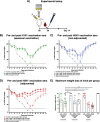Influenza Virus Hemagglutinin Stalk-Specific Antibodies in Human Serum are a Surrogate Marker for In Vivo Protection in a Serum Transfer Mouse Challenge Model
- PMID: 28928215
- PMCID: PMC5605943
- DOI: 10.1128/mBio.01463-17
Influenza Virus Hemagglutinin Stalk-Specific Antibodies in Human Serum are a Surrogate Marker for In Vivo Protection in a Serum Transfer Mouse Challenge Model
Abstract
The immunogenicity of current influenza virus vaccines is assessed by measuring an increase of influenza virus-specific antibodies in a hemagglutination inhibition assay. This method exclusively measures antibodies against the hemagglutinin head domain. While this domain is immunodominant, it has been shown that hemagglutination inhibition titers do not always accurately predict protection from disease. In addition, several novel influenza virus vaccines that are currently under development do not target the hemagglutinin head domain, but rather more conserved sites, including the hemagglutinin stalk. Importantly, antibodies against the hemagglutinin stalk do not show activity in hemagglutination inhibition assays and will require different methods for quantification. In this study, we tested human serum samples from a seasonal influenza virus vaccination trial and an avian H5N1 virus vaccination trial for antibody activities in multiple types of assays, including binding assays and also functional assays. We then performed serum transfer experiments in mice which then received an H1N1 virus challenge to assess the in vivo protective effects of the antibodies. We found that hemagglutinin-specific antibody levels measured in an enzyme-linked immunosorbent assay (ELISA) correlated well with protection from weight loss in mice. In addition, we found that weight loss was also inversely correlated with the level of serum antibody-dependent cellular cytotoxicity (ADCC) as measured in a reporter assay. These findings indicate that protection is in part conferred by Fc-dependent mechanisms. In conclusion, ELISAs can be used to measure hemagglutinin-specific antibody levels that could serve as a surrogate marker of protection for universal influenza virus vaccines.IMPORTANCE Influenza viruses are a serious concern for public health and cause a large number of deaths worldwide every year. Current influenza virus vaccines can confer protection from disease, but they often show low efficacy due to the ever-changing nature of the viruses. Novel vaccination approaches target conserved epitopes of the virus, including the hemagglutinin stalk domain, to elicit universally protective antibodies that also bind to mutated viruses or new subtypes of viruses. Importantly, the hemagglutination inhibition assay-the only assay that has been accepted as a correlate of protection by regulatory authorities-cannot measure antibodies against the hemagglutinin stalk domain. Therefore, novel correlates of protection and assays to measure vaccine immunogenicity need to be developed. In this study, we correlated the results from multiple assays with protection in mice after transfer of human serum and a lethal virus challenge to investigate potential novel serological surrogate markers for protection.
Keywords: ADCC; ELISA; correlate of protection; hemagglutinin; hemagglutinin stalk; influenza; influenza vaccines; surrogate marker; universal influenza virus vaccine.
Copyright © 2017 Jacobsen et al.
Figures




Similar articles
-
Induction of broadly reactive anti-hemagglutinin stalk antibodies by an H5N1 vaccine in humans.J Virol. 2014 Nov;88(22):13260-8. doi: 10.1128/JVI.02133-14. Epub 2014 Sep 10. J Virol. 2014. PMID: 25210189 Free PMC article.
-
Inactivated H7 Influenza Virus Vaccines Protect Mice despite Inducing Only Low Levels of Neutralizing Antibodies.J Virol. 2017 Sep 27;91(20):e01202-17. doi: 10.1128/JVI.01202-17. Print 2017 Oct 15. J Virol. 2017. PMID: 28768855 Free PMC article.
-
Impact of pre-existing immunity on the induction of functional cross-reactive anti-hemagglutinin stalk antibodies following vaccination with an AS03 adjuvanted pandemic H1N1 vaccine.Vaccine. 2018 Apr 12;36(16):2213-2219. doi: 10.1016/j.vaccine.2018.02.022. Epub 2018 Mar 13. Vaccine. 2018. PMID: 29548607
-
Meeting report and review: Immunological assays and correlates of protection for next-generation influenza vaccines.Influenza Other Respir Viruses. 2020 Mar;14(2):237-243. doi: 10.1111/irv.12706. Epub 2019 Dec 13. Influenza Other Respir Viruses. 2020. PMID: 31837101 Free PMC article. Review.
-
Implications of broadly neutralizing antibodies in the development of a universal influenza vaccine.Curr Opin Virol. 2016 Apr;17:110-115. doi: 10.1016/j.coviro.2016.03.002. Epub 2016 Mar 28. Curr Opin Virol. 2016. PMID: 27031684 Free PMC article. Review.
Cited by
-
Influenza Anti-Stalk Antibodies: Development of a New Method for the Evaluation of the Immune Responses to Universal Vaccine.Vaccines (Basel). 2020 Jan 24;8(1):43. doi: 10.3390/vaccines8010043. Vaccines (Basel). 2020. PMID: 31991681 Free PMC article.
-
CD4+ follicular regulatory T cells optimize the influenza virus-specific B cell response.J Exp Med. 2021 Mar 1;218(3):e20200547. doi: 10.1084/jem.20200547. J Exp Med. 2021. PMID: 33326020 Free PMC article.
-
Modulation of lipid nanoparticle-formulated plasmid DNA drives innate immune activation promoting adaptive immunity.Cell Rep Med. 2025 Apr 15;6(4):102035. doi: 10.1016/j.xcrm.2025.102035. Epub 2025 Mar 21. Cell Rep Med. 2025. PMID: 40120578 Free PMC article.
-
Assessment of Fcγ receptor-dependent binding of influenza hemagglutinin vaccine-induced antibodies in a non-human primate model.iScience. 2022 Sep 6;25(10):105085. doi: 10.1016/j.isci.2022.105085. eCollection 2022 Oct 21. iScience. 2022. PMID: 36147947 Free PMC article.
-
A mosaic hemagglutinin-based influenza virus vaccine candidate protects mice from challenge with divergent H3N2 strains.NPJ Vaccines. 2019 Jul 19;4:31. doi: 10.1038/s41541-019-0126-4. eCollection 2019. NPJ Vaccines. 2019. PMID: 31341648 Free PMC article.
References
-
- Russell K, Blanton L, Kniss K, Mustaquim D, Smith S, Cohen J, Garg S, Flannery B, Fry AM, Grohskopf LA, Bresee J, Wallis T, Sessions W, Garten R, Xu X, Elal AI, Gubareva L, Barnes J, Wentworth DE, Burns E, Katz J, Jernigan D, Brammer L. 2016. Update: influenza activity—United States, October 4, 2015–February 6, 2016. MMWR Morb Mortal Wkly Rep 65:146–153. doi:10.15585/mmwr.mm6506a3. - DOI - PubMed
Publication types
MeSH terms
Substances
Grants and funding
LinkOut - more resources
Full Text Sources
Other Literature Sources
Medical
